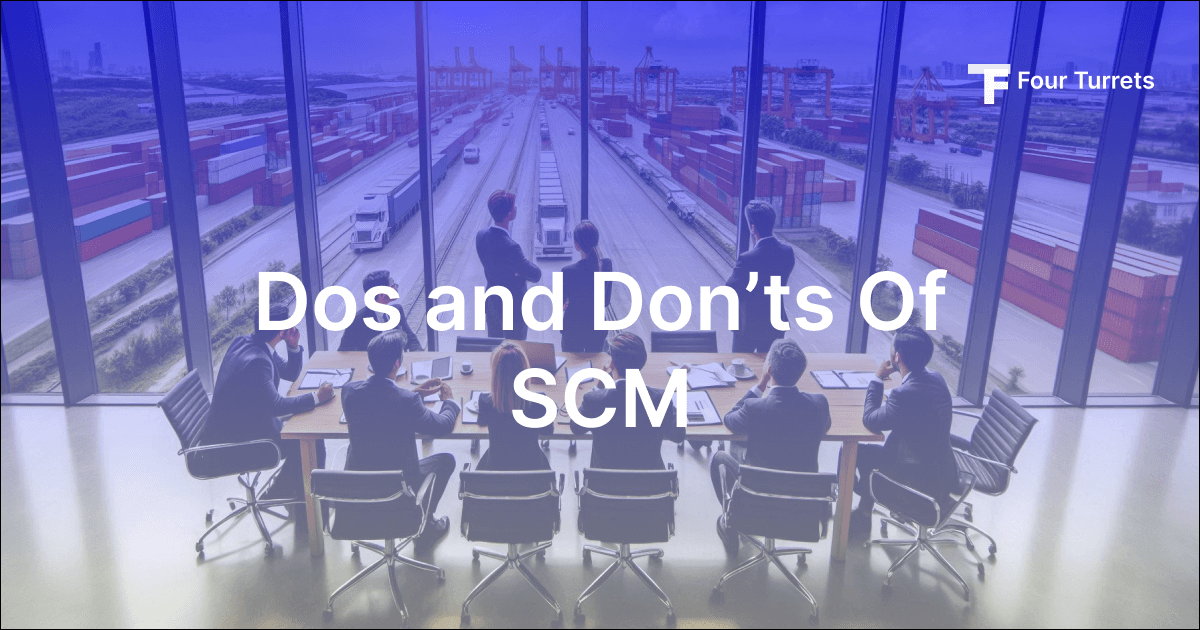Supply chain management is a huge opportunity to play around with. Starting from managing operations of movement of goods to managing the efficiency in manufacturing operations, there are many things in our world that depend on supply chain management.
Let’s find out the dos and don’ts of supply chain management. But, before that, let’s understand what is supply chain management.
What is Supply Chain Management?
Supply Chain Management is a critical discipline that focuses on overseeing and coordinating logistics, procurement, and inventory management to ensure seamless supply chain operations. It involves managing relationships with suppliers and other stakeholders to optimize the entire supply chain and maintain a competitive edge in the global supply market. A robust management system is essential to streamline processes, enhance supply chain visibility, and mitigate supply chain disruptions that could impact customer satisfaction.
To optimize your supply chain, businesses must leverage technology to provide real-time data and insights, which can help identify potential problems in your supply chain. This includes addressing vulnerability points and implementing effective change management strategies. Foreseeing disruption and adapting quickly is crucial for logistics and shipment management. Moreover, reverse logistics should not be overlooked, as it is equally important in maintaining a healthy supply chain.
When considering the dos and don’ts of supply chain management, it is important to ensure you’re aware of factors that can optimize or hinder your operations. Supply chain management includes fostering strong relationships with suppliers and ensuring visibility across global supply chains. On the contrary, don’t assume that traditional methods will always suffice; continuous improvement and adaptation are key to success.
Supply Chain Management Dos
Here are some of the do’s for SCM to make sure your organization achieves the best outcomes.
Always Review The Supply Chain Process
A good supply chain does not have only one or two components in the system. It has multiple stakeholders, multiple processes, and stages in it. Thus, to optimize it, an organization should always make sure to review it and start improving it step-by-step.
Identify Areas of Innovation
Once you start reviewing your supply chain, make sure to start improving with the help of small innovations. ie, adapting new technologies, onboarding new partners, or streamlining the internal processes. To take informed decisions, companies need to act proactively as well.
Be Proactive With Management System
When you implement an SCM within the organization, you need to make sure that all the updates and steps you take should help you maximize the process output. A proactive attitude to make your process better will help you remove inaccuracy in tracking and help you make the business strategy better.
Communication for Better Visibility
Lack of communication can hinder the process. Thus, to keep the transparency going within all participating stakeholders and improve operations, identify issues and keep the communication going. A well-informed team helps the business decision-makers take the right decisions based on real-time updates taking place in the entire process within the organization.
Risk Management
To make sure all the business needs are met at the inventory levels, risk management is a necessary step in the ongoing process. Actionable items must be listed, and here technology helps organizations manage warehouse operations at optimal levels. Risk management process will help you identify poor communication within the key components of the system as well.
Supply Chain Don’ts
Here are some of the most common don’ts for the SCM to save your resources.
Don’t Treat it as a One-Time Deal
Whether you are a manufacturing organization or a trading organization, you need to pave the way to make your operations better. Using actionable insights from the past shipments to manage your upcoming transactions will help you run processes above suboptimal levels. To maintain product quality, do not treat your supply chain management operations as a one-time deal. Do proper documentation within the organization and manage your inventory systems efficiently to create a major impact.
Don’t Get Side-tracked By a Minor Issue
While working on SCM improvements within your systems, do not get side-tracked or carried away with the minor issues in the operations. Instead, when you face minor issues within the system, try to solve them as early and as effectively as possible at your end. This will make sure you’re on the right track.
Don’t See Partnerships In The Short-Term
Not seeing any partnership as a short-term partnership is the best advice people generally get. All the acting partners and stakeholders within the supply chain must stay together to make the system effective and efficient for a longer period. Broken relationships will hinder the growth trajectory.
Don’t Be Afraid of Progress
Process will come with the improvements of supply chain management systems. A lot of new documentation and adoption of process will take place when you are trying to make things efficient. So, do not be afraid of adopting these new processes and longer processes in the initial phase, it will only make you stronger.
Every business aims for a successful supply chain management, which is key in achieving this. By proactively identifying areas of improvement within the supply chain, companies can make informed decisions and optimize supply processes. Technological advancements, such as automation, equip businesses to streamline logistics operations and enhance cash flow. However, logistics can be complicated, and a lack of communication can end up costing dearly.
When it comes to logistics, it’s essential to understand the do’s and don’ts. For instance, best practices involve collaborating with reliable logistics providers and ensuring clear communication across the entire operation. The pandemic has shown the necessity of flexibility, and it’s equally important to identify issues early to mitigate risk. By focusing on end-to-end solutions, businesses can ensure they’re ready to adapt.



